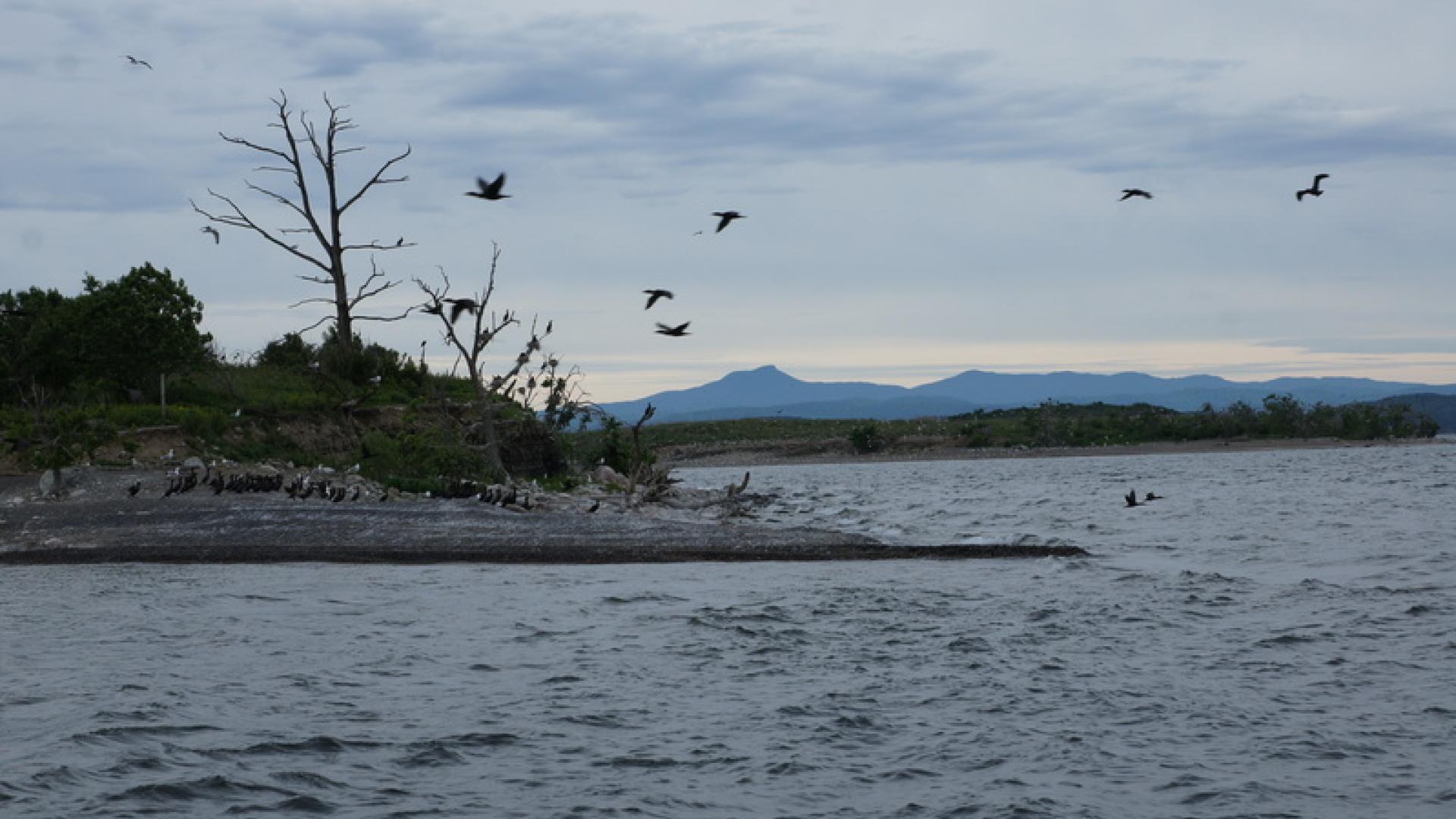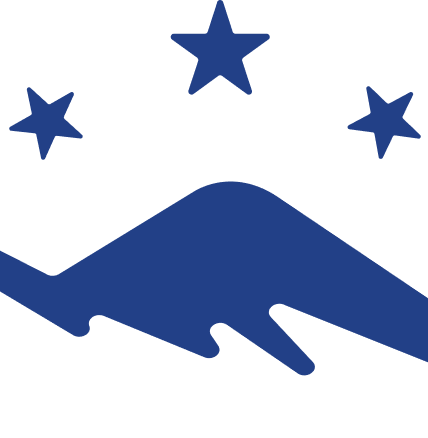An overcast day on the water
The day was gray and overcast as five birding friends and I set off from Willsboro Marina to visit the Four Brothers Islands in Lake Champlain. I had never been to the islands before, but my friend had set up a trip with a local charter company (which usually takes fishermen) and it seemed like a good opportunity to check the islands out. After all, the Four Brothers are well known in the local birding world for the colonially breeding birds they support, and I was hoping to get some decent photos.
That hope would be tested by the dark gray conditions, but we were all excited and chatted over the noise of the motor as we made our way through Willsboro Bay, toward the islands. I snapped shots of the surrounding hills and Rattlesnake Mountain, which hugs the western shore of the bay. Our species list would not be long — we knew that a fairly small number of species would be found on the islands — but we started checking birds off soon after we left the marina.
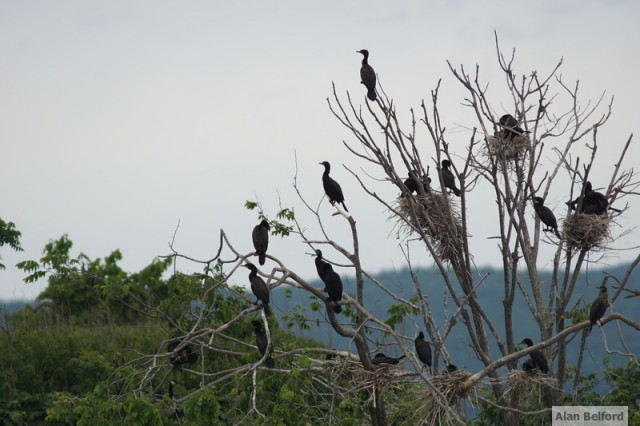
The islands
After about 20 minutes the boat captain cut the engines as we began to approach the islands. Aptly named by their collective number — as there are four of them — the names for the individual islands fall short in creativity and they are simply known as A, B, C, and D. Adding to this poor naming choice is the order of the islands which run as D, C, A, and B from west to east. We reached D first as a result.
The island’s broken snags of trees were topped with the nests of Great Blue Herons and Double-crested Cormorants, as gulls — mostly Herring and Great Black-backed on this island (there were a few Ring-billed as well) — nested on the ground or on the surrounding rocks. We spotted several gull chicks — cute gray and black speckled puffballs — sitting with an adult or waiting for their parents to arrive with food.
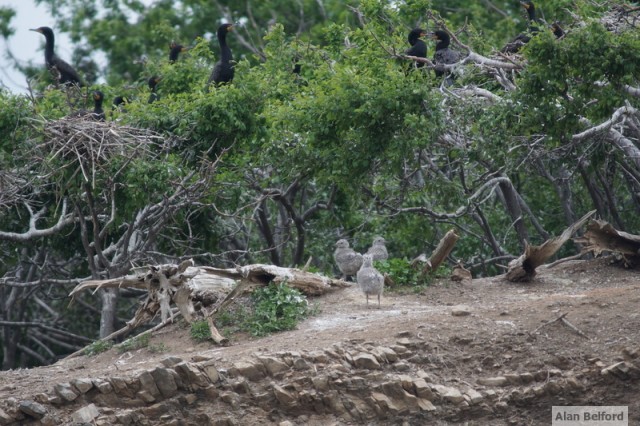
These species comprised a lot of what we saw while out at the islands. The trick was to pick through them and hope to find a less common species. In this way island D offered us two Black-crowned Night Herons — one adult and one young bird — one of the regionally uncommon species we were hoping to see. We also had a few Song Sparrows, Common Grackles, Tree Swallows, and European Starlings to add some songbirds to the aquatic focus of the outing.
Searching for Egrets and Herons
Having slowly looped D, we directed our bow for B, the island of most interest to birders since its thicker vegetation offers breeding locations not only for Black-crowned Night Herons but also for Great Egrets and Cattle Egrets, the latter of which is the trickiest breeder to find and the species my friends most wanted to see. Cattle Egrets aren’t rare but they are regionally rare, and the few that nest on the Four Brothers seem to feed in Vermont for much of the day, making finding them more difficult.
We looped B without any luck on the Cattle Egrets, although we saw both Great Egrets and Black-crowned Night Herons multiple times as we would throughout the morning. So we looped B again and still had no luck, although we did find a Semi-palmated Sandpiper as a small consolation prize. The egrets were apparently off feeding, meaning we needed to spot them in flight or they were hunkered down on their nests on the center of the steep-walled island.
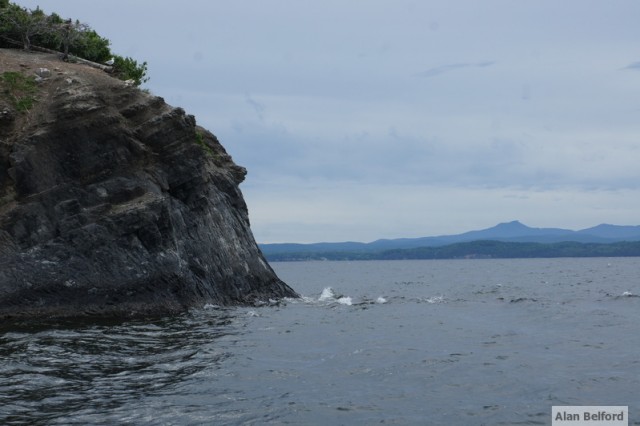
We looped A to change our luck, keeping an eye on the horizon since our best bet was to find a bird in flight. Island A was less active than the other islands, but it did have a few swallows, including several Tree Swallows as well as both Barn and Northern Rough-winged Swallows. I scanned the open waves regularly (which were growing with an increasing wind) in case anything of interest was cruising over the lake, but found nothing of note. As I did this we discussed how late summer and early fall would be a great time to take such a boat trip as migrants and dispersing birds might be moving along the lake. Stay tuned for another blog if we do that.
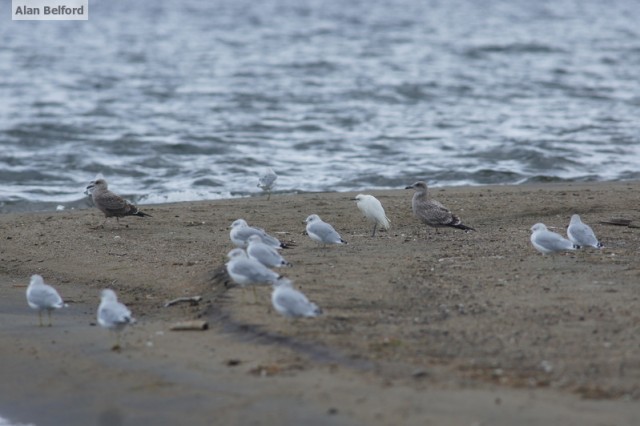
A place belonging to the Birds
We would loop B again, finding a Spotted Sandpiper, and we then looped C with its cacophony of Ring-billed Gulls and Caspian Terns. We never did get lucky with a Cattle Egret — my friends will just have to go back. Despite this, the trip was great. More interesting than finding an uncommon species, the experience was about the constant noise, chatter, and bustle of a breeding colony of birds. It is the shapes, flutter, and activity of the location which makes the Four Brothers intriguing. Interested birders will find the trip just as much fun as we did – the distance can be paddled by experienced kayakers on a calm day, but it is recommended that you take a small motor boat. Just be sure not to land on shore and disturb the local residents.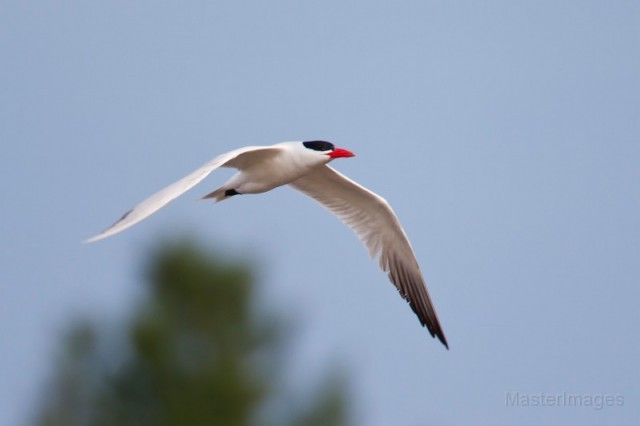
And that may be the biggest appeal of the Four Brothers — the fact that few people go there. It is a place where the birds dominate these tiny outposts of land in a world of water. They are a place where people are clearly outsiders and should do their best to remain so. And we were permitted to enter into that place for a brief time and observe the rhythm of the sounds, sights, and yes, the smells of the islands. It is a unique experience in the region and one I bet I'll do again.
Now is a great time to plan your summer Champlain birding trip! Check out our outdoor recreation, lodging, and dining pages to learn more!

